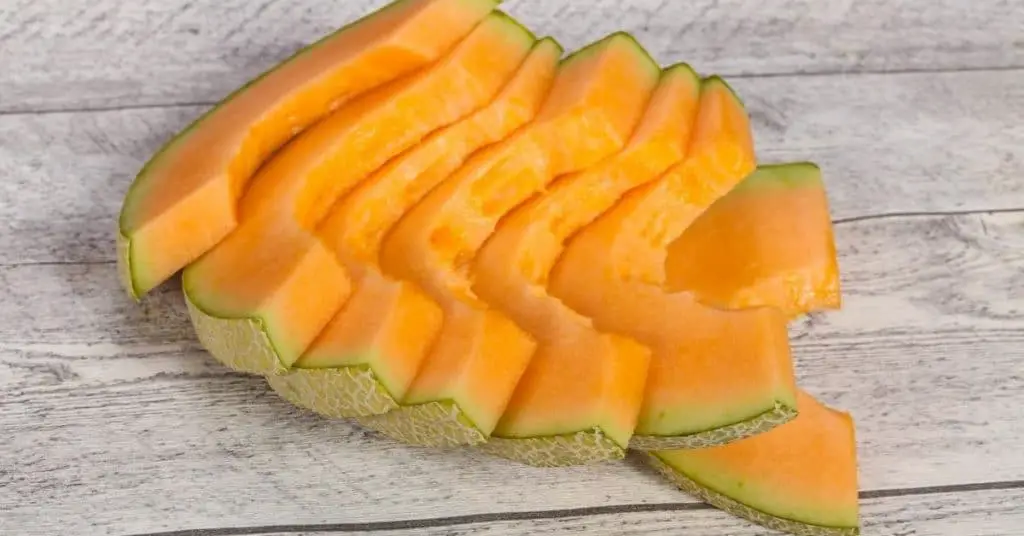In a nutshell: Yes, you can freeze cantaloupe to preserve it for future use in various recipes such as fruit salads, smoothies, sorbets, and more. Although the texture may change slightly, frozen cantaloupe remains flavorful and versatile.
Cantaloupe is a deliciously sweet and juicy summer melon. However, as with most ripe fruit, once cut, it does not have a long shelf life. So how can you preserve some of this tasty orange-colored summer fruit for year-round enjoyment? Freeze it!
Yes, despite its high water content, cantaloupe can be frozen. In this cantaloupe freezing guide, you will learn how to preserve the melon in the freezer for up to a year and discover delicious ways to use it after thawing.
Can Cantaloupe Be Frozen?
Cantaloupe may not retain its firm texture completely on freezing, but you can freeze cantaloupes to preserve them for long-term use. Once thawed, cantaloupe will still be great to add to fruit salad and will be a perfect addition to smoothies.
Other fantastic things one can make with frozen cantaloupe is sorbet, fruit compote, melon gazpacho, cantaloupe ice cream, frozen yogurt, and cantaloupe cocktails. In fact, there are so many delicious things to make with frozen cantaloupes that you may want to purchase a double batch specifically to place some of it in the freezer.
Since cantaloupe is largely made of water, it is prone to spoil easily. Take special care by following the below instructions when freezing cantaloupe.
How To Freeze Cantaloupe
For the best quality, always pick fresh cantaloupes that have just been cut. If you are freezing leftover cantaloupe that has already been sliced and refrigerated for a day, make sure it is still firm and slightly crisp. Avoid freezing any soggy or soft parts as these will not freeze well and are prone to breeding harmful bacteria.
Step 1: Wash
Give uncut cantaloupe a good wash in cold water before handling.
Step 2: Deseed and Cut
Halve the cantaloupe and remove the inner seeds. Use a melon-baller to scoop out small round balls or carve the flesh away from the peel with a sharp knife and then cut it into chunks or slices
Step 3: Prepare and Pack
There are different ways in which you can prepare the cantaloupe for freezing. The method you choose may depend on how you wish to use the cantaloupe after freezing.
Option 1: Cubes
Once you have cut cubes or made cantaloupe balls, portion the pieces into the amount you would want to defrost at a time. One to two cup portions are ideal.
Coating the fruit in sugar will help to preserve the flavor and color whilst frozen. Sprinkle granulated sugar over the fruit and toss to coat well.
Place the sugar-coated cantaloupe chunks into ziplock freezer bags and press out any air before sealing tightly. Alternatively use a freezer-friendly airtight container. Plastic wrap is not ideal, but if its all you have on hand, wrap the melon in a few layers to make sure there are no gaps.
Option 2: Sugar Syrup
Another way to help preserve the cantaloupe flavor and texture is by submerging the fruit in a simple syrup. The result after thawing will be somewhat similar to canned fruit. This method is ideal if using the cantaloupe in a dessert, cocktail, or smoothie.
To make a light sugar syrup, combine 9 cups of water with 2 ¼ cups of granulated sugar (1200ml water and 425g sugar). Heat them together in a saucepan. Bring the mixture to the boil and stir until the sugar has completely dissolved. Once dissolved, the mixture will be clear or slightly white, remove it from the heat and let it cool.
Portion the melon chunks into airtight freezer-friendly containers or ziplock freezer bags. Pour the cooled syrup over the cantaloupe pieces until just covered. If using a container, place a piece of parchment paper against the surface of the fruit to keep it submerged and protected from the air before closing.
If using freezer bags, press out any air before sealing them.
Option 3: Puree
Freezing pureed cantaloupe is perfect for use in smoothies. Place the cut cantaloupe in a blender and blitz until smooth. Pour the puree into an ice cube tray and place in the freezer to harden completely. Once fully frozen, remove the cubes from the tray and place them into a freezer bag, removing the air from the bag before sealing.
If preferred, you can also freeze the puree in larger portions instead of in ice cubes. Pour the puree into freezer containers or a ziplock freezer bag. Make sure to press out the air from the top of the bag before sealing to prevent freezer burn.
Step 4: Label and Freeze
Regardless of the method you have chosen, label the container or freezer bags with the date. This way you can keep track of how long you have stored the cantaloupe in the freezer. When you place the cantaloupe in the freezer, make sure it won’t get squashed by other heavy items.
How To Thaw Frozen Cantaloupe
To defrost the cantaloupe, simply remove it from the freezer and place it in the fridge. It is best to put the container or freezer bag onto a plate or in a bowl to catch any water running off the container during thawing. Leave overnight to thaw. If frozen in a sugar syrup, stir the mixture occasionally.
Do not leave the cantaloupe to thaw at room temperature. If you are using it in a smoothie, you can add it directly from the freezer without thawing.
Types of Cantaloupe
Although European Cantaloupe and North American Cantaloupe have slightly different outer skin, they both offer a sweet and juicy orange flesh and similar taste. It has many names such as sweet melon, rockmelon, or spanspek
The center of the melon contains seeds that are usually removed before cutting, however, the seeds can be eaten, or dried and used as snacks.
Cantaloupe is most often eaten plain sliced, in a fruit salad, as part of a fruit platter or for dessert with ice cream. Cantaloupe can also be paired with prosciutto for a perfectly sweet-salty combination.
FAQs
Conclusion
Although high in water content, cantaloupe can be frozen to preserve its color and natural sweetness. The melon may slightly change texture on thawing and not be as firm as it is when fresh but can still be eaten in many delicious applications.
Preserving cantaloupe in a sugar syrup or coating it with granular sugar when freezing will enhance its preservation. It is also vital to protect the fruit from contact with air when freezing, keeping it well sealed.
Whizz pureed cantaloupe ice-cubes with other ingredients to make a refreshing smoothie or cocktail. Frozen cantaloupe is a sweet taste sensation when used in melon sorbets, ice creams, in fruit salads, or turned into compote. Now you can enjoy summer sweetness all year long.
Up Next: Can You Freeze Pears? A Complete Guide for Fruit Lovers
Image by depositphotos/AndreySt









